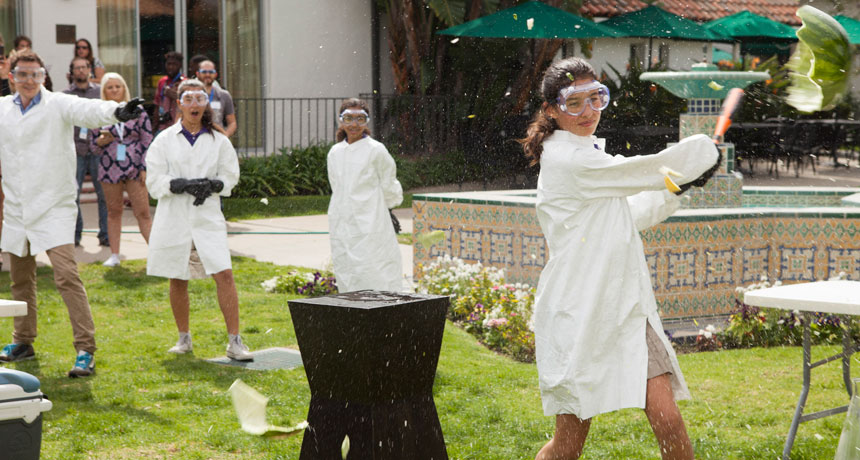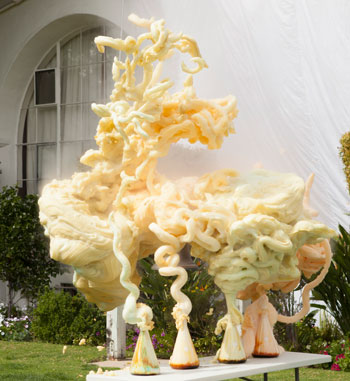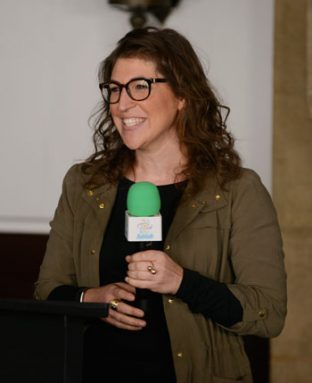‘FabLab’ brings cool science to TV
Weekly new science show aims to get TV viewers — especially girls — involved in STEM

A student has just whacked a frozen watermelon with a baseball bat.
Michael Bezjian / Getty Images
By Gerri Miller
LOS ANGELES, Calif. — Half of all U.S. workers are women. Still, women hold less than one in every four jobs in science, technology, engineering and math, the so-called STEM fields. That’s according to a U.S. Department of Commerce study. A new weekly TV show aims to change that. Called Fablab, it features cool science news, fun experiments and interactive elements designed to engage tweens and teens in STEM projects.

Although girls’ interest in STEM is growing, “it hasn’t changed enough,” Brown argues. Indeed, girls often haven’t felt welcome doing science and engineering. “That’s why a show that presents girls doing neat stuff and solving problems is so important,” he says. “Girls bring a unique perspective to technological developments and creating new products and services that could be valuable to all of us.” The show isn’t just for girls. But, Brown notes, “We want to make sure that people of both genders who are interested in STEM are given [a career] opportunity.”
FabLab announced the debut of the series on March 3 at the Archer School for Girls, here in Los Angeles. It was also taping a new episode. Nick Uhas, one of the four co-hosts, conducted a fun experiment with help from Archer School students. He immersed a hollowed-out watermelon in a mixture of isopropyl (rubbing) alcohol and dry ice. This froze the fruit solid. When a volunteer hit it with a baseball bat, the fruit shattered as if it were made of glass.

It’s one thing to observe the world and what’s happening within it. But people who are curious will also want to know how and why things happen as they do. “I love science,” Uhas says, because it offers those explanations. “Not only is that empowering,” he says, but also “it puts your brain at ease.”
Always interested in biology, Uhas joined the science club in high school. He had planned to be a doctor. But he’s having a lot more fun now teaching kids about science, he says. He made a video for his Nikipedia YouTube channel showing how burning Doritos in a barbecue can cook a steak. In fact, he notes, his YouTube series helped land him the job at FabLab.
Ask Big Bang’s Mayim
These days, actress Mayim Bialik is best known as neuroscientist Amy Farrah Fowler in the CBS series The Big Bang Theory. But in real life, she also has a PhD in neuroscience. She studied the brain and the nervous system at the University of Southern California in Los Angeles, both in college and as a graduate student.

“Getting girls involved in science is a personal passion of mine,” says Bialik. “Through my interactive ‘Ask Mayim’ segment [on Fablab], I hope to get more young women excited about getting into the field that I love so much.” On the show, Bialik will answer questions like: What is El Niño and what makes it happen, “what made you get into neuroscience” or how do I get involved in STEM programs? Launching in late spring, Bialik’s segments will air weekly on the FabLab YouTube channel, on FabLabTV.com, on other social media and sometimes on the TV show.
Uhas, 30, notes that there was no YouTube or shows like FabLab when he was growing up. He thinks today’s students have many great options to get involved in STEM, both in and outside the classroom. “STEM teaches you to creatively solve problems quickly. And those skills help you not only in a career but life in general,” he says. “You don’t have to be a brainiac. You just need to be interested in making the world a better place, and finding a way to do that.”
FabLab airs every weekend on FOX stations. Check your local listings for details. Or visit the show’s new YouTube channel. Interested in becoming a guest reporter or host? The show is recruiting people at its website.
Power Words
(for more about Power Words, click here)
biology The study of living things. The scientists who study them are known as biologists.
El Niño Extended periods when the surface water around the equator in the eastern and central Pacific warms. Scientists declare the arrival of an El Niño when that water warms by at least 0.4 degree Celsius (0.72 degree Fahrenheit) above average for five or more months in a row. El Niños can bring heavy rainfall and flooding to the West Coast of South America. Meanwhile, Australia and Southeast Asia may face a drought and high risk of wildfires. In North America, scientists have linked the arrival of El Niños to unusual weather events — including ice storms, droughts and mudslides.
engineering The field of research that uses math and science to solve practical problems.
gender The attitudes, feelings, and behaviors that a given culture associates with a person’s biological sex. Behavior that is compatible with cultural expectations is referred to as being the norm. Behaviors that are incompatible with these expectations are described as non-conforming.
geyser A vent (opening) in Earth’s surface that intermittently sends up a tall spray of steam or hot water. The sometimes explosive discharge of water and steam is propelled by the geothermal heating of water below ground.
graduate student Someone working toward an advanced degree by taking classes and performing research. This work is done after the student has already graduated from college (usually with a four-year degree).
isopropyl alcohol Also known as rubbing alcohol, it has a chemical formula C₃H₈O or C₃H₇OH or CH₃CHOHCH₃. It is a colorless, flammable chemical with a strong odor.
neuroscience Science that deals with the structure or function of the brain and other parts of the nervous system. Researchers in this field are known as neuroscientists.
hydrogen peroxide A molecule made of two hydrogen and two oxygen atoms. Highly reactive, it can kill many tiny organisms, including germs.
nervous system The network of nerve cells and fibers that transmits signals between parts of the body.
oxygen A gas that makes up about 21 percent of the atmosphere. All animals and many microorganisms need oxygen to fuel their metabolism.
PhD (also known as a doctorate) A type of advanced degree offered by universities — typically after five or six years of study — for work that creates new knowledge. People qualify to begin this type of graduate study only after having first completed a college degree (a program that typically takes four years of study).
potassium iodide An inorganic compound with the chemical formula KI. It is used to treat thyroid-gland conditions as well as breathing problems such as asthma, emphysema and bronchitis.
STEM An acronym (abbreviation made using the first letters of a term) for science, technology, engineering and math.







